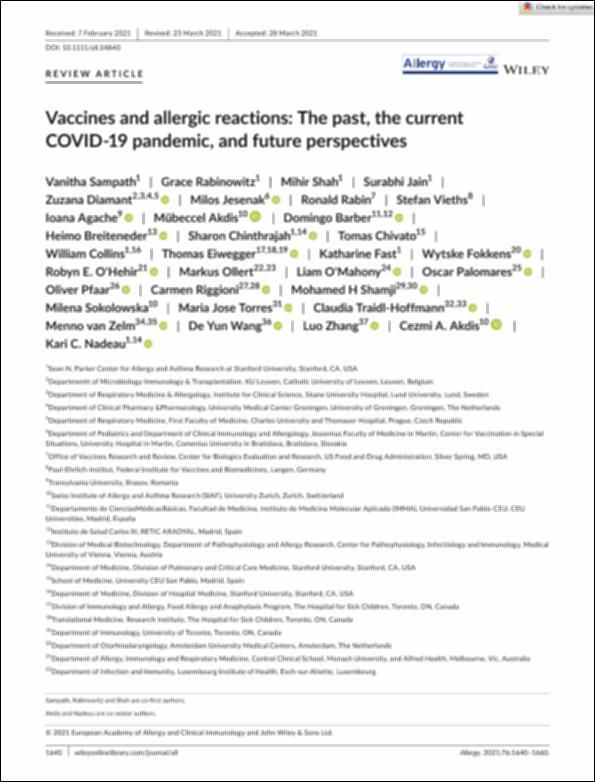Please use this identifier to cite or link to this item:
http://hdl.handle.net/10637/15133Vaccines and allergic reactions: The past, the current COVID-19 pandemic, and future perspectives
| Title: | Vaccines and allergic reactions: The past, the current COVID-19 pandemic, and future perspectives |
| Authors : | Sampath, V. Rabinowitz, G. Shan, M. Jain, S. Diamant, Z. Jesenak, M. Rabin, R. Vieths, S. Akdis, Mubeccel Barber Hernández, Domingo Breiteneder, H. Chivato Pérez, Tomás Collins, W. Eiwegger, Thomas Fast, K. Fokkens, W. O'Hehir, R. E. Ollert, Markus O'Mahony, Liam Palomares, Oscar Pfaar, Oliver Riggioni, Carmen Shamji, M. H. Sokolowska, Milena Agache, Ioana Chinthrajah, S. José Torres, M. Traidl Hoffmann, C. Van Zelm, M. Wang, Y. Zhang, Luo Akdis, Cezmi A. Nadeau, Kari C. |
| Keywords: | Allergy; Anaphylaxis; COVID-19; SARS-CoV- 2; Vaccine |
| Publisher: | Wiley |
| Citation: | Sampath V, Rabinowitz G, Shah M, et al. Vaccines and allergic reactions: The past, the current COVID-19 pandemic, and future perspectives. Allergy. 2021;76:1640–1660. https://doi.org/10.1111/all.14840 |
| Abstract: | Vaccines are essential public health tools with a favorable safety profile and prophylactic effectiveness that have historically played significant roles in reducing infectious disease burden in populations, when the majority of individuals are vaccinated. The COVID-19 vaccines are expected to have similar positive impacts on health across the globe. While serious allergic reactions to vaccines are rare, their underlying mechanisms and implications for clinical management should be considered to provide individuals with the safest care possible. In this review, we provide an overview of different types of allergic adverse reactions that can potentially occur after vaccination and individual vaccine components capable of causing the allergic adverse reactions. We present the incidence of allergic adverse reactions during clinical studies and through post-authorization and post-marketing surveillance and provide plausible causes of these reactions based on potential allergenic components present in several common vaccines. Additionally, we review implications for individual diagnosis and management and vaccine manufacturing overall. Finally, we suggest areas for future research. |
| URI: | http://hdl.handle.net/10637/15133 |
| Rights : | http://creativecommons.org/licenses/by-nc-nd/4.0/deed.es |
| ISSN: | 1398-9995 |
| Issue Date: | Jun-2021 |
| Center : | Universidad San Pablo-CEU |
| Appears in Collections: | Medicina |
Items in DSpace are protected by copyright, with all rights reserved, unless otherwise indicated.


